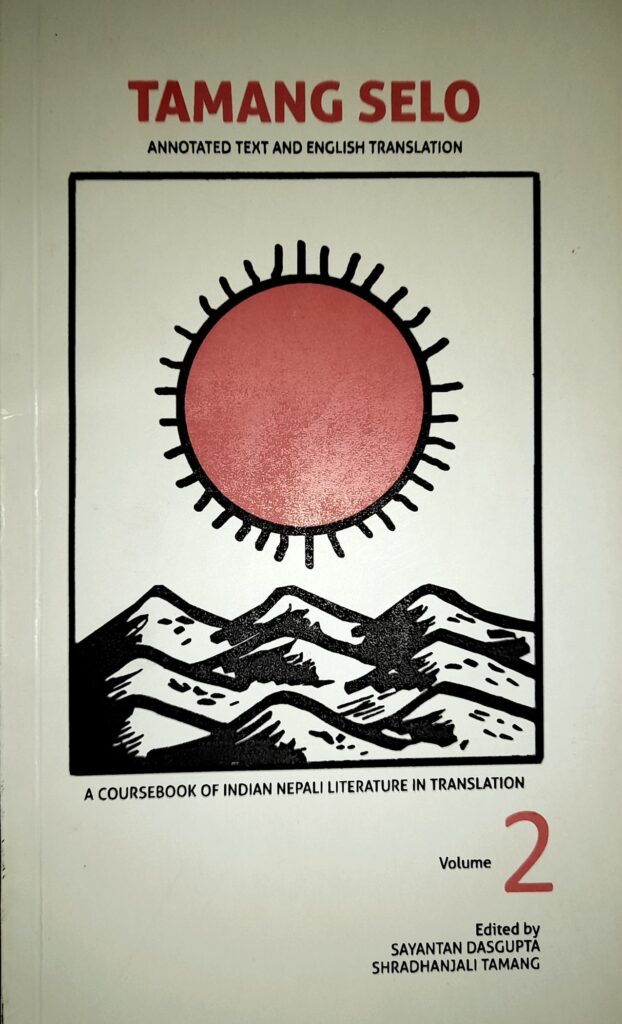A BOOK REVIEW BY ARATRIKA GANGULY
Tamang Selo: An Anthology (Annotated Text and English Translation), edited by Sayantan Dasgupta and Shradhanjali Tamang, was published from Jadavpur University Press in collaboration with Centre for Translation of Indian Literatures, Jadavpur University, in 2015. This book is a remarkable step in the process towards documenting the enriching tradition of the Tamang Selo songs. This is the second volume of the series while the first volume is named as Call of the Hills: A Coursebook of Indian Nepali Literature in Translation edited by Sayantan Dasgupta and Kabita Lama was first published in 2012. The first volume consists of nineteen short stories from Darjeeling area of the Himalayas. This volume consists of the English translation of these short stories from Indian Nepali. Divided into two sections, the first sections deal with theoretical essays that introduces the history of the short story in Nepali literature and also introduces certain Indian Nepali writers. These essays also highlight the social, cultural, and economic issues of Darjeeling area. This book was a result of the collaboration of Department of Comparative Literature, Jadavpur University and Southfield College, Darjeeling.
Both the volumes, Call of the Hills: A Coursebook of Indian Nepali Literature in Translation and Tamang Selo: An Anthology (Annotated Text and English Translation), is an attempt to make Nepali texts and the culture of the Himalayas more accessible to the people of the plains as well as the students of literature. Both the books have been popular among the general as well as academic audience. The second book, Tamang Selo: An Anthology, makes a valuable contribution to the Himalayan musical culture of the Indian Nepali language. Songs have been collected and translated by scholars and students of Jadavpur University, Department of Comparative Literature. These songs reflect the pluricultural life of the Himalayan people. Furthermore, these songs are collected from people of Tamang community, and they capture various emotions, events, and moments of the Tamang people as well the Indian Nepali people in general. This book is a bilingual volume and is divided into three sections. The first sections introduce the concept of Tamang Selo, the history of Tamang culture as well many technicalities of the Tamang Selo songs. The second section consists of the Tamang Selo in Nepali and the third section consists of the English translation of the Nepali songs present in the earlier section.
The book mainly focuses on the folk songs and their translation but unless one gets acquainted with the history of the Tamang community or why their songs also known as Selo are sung in Nepali, it is impossible to comprehend the essence of these songs. Hence, the introduction and the three essays in the section I sets the tone for the rest of the book. Part of Project Anuvad that was undertaken by the Centre for Translation of Indian Literatures (CENTIL), Jadavpur University, this book tries to highlight the folk as well marginalized folk songs of the Himalayan region by focusing on the particular genre of Tamang Selo songs.
The Tamang community is originally a Tibeto-Burman community that can trace its ancestry back to Tibet and Mongolia. However, in the contemporary times, they are scattered throughout Nepal, Myanmar, and Bhutan; in India, they are found in Darjeeling, Sikkim, Assam, and Nagaland. There is an amalgam of Tibetan and other Himalayan cultures in the Tamang culture. There are also many subcastes among Tamangs. The Tamang language is an endangered language of the Himalayas, and the community now falls under the various traditional communities that creates the Indian Nepali community. The oral tradition of the Tamang community is very enriched but because of the dominant status of the Nepali language all over the eastern Himalayas of India, the songs of the Tamang community are sung in Indian Nepali and is penned down in the same language. In this way, the genre of Selo has become a melting pot of diverse Indian Nepali cultures from various regions of the Himalayas. The translations by the contributors have kept the unique essence of the Selo alive. In Nepali, the songs are called Selo, and the rhythm, style and beat are taken from the Tamang community’s oral tradition. The song is also known as Damphu Geet since it is sung using the Damphu instrument. The themes are universal in nature like of love and people’s association with nature and certain songs are about traditional events, daily occurrences, and lifestyle of the Tamang community.
This book is an important contribution in the field of Nepali literature, culture, and ethnomusicology. This book is well-suited for students of Nepali literature and culture, Comparative Literature, Cultural Studies, Translation Studies, Folk Studies, and Ethnomusicology. It bridges the gap between mainstream study of Indian Nepali literature and the study of marginalized communities within the mainstream Indian Nepali culture. The performative genre of the Tamang Selo have never been considered a part of the wider folk traditions of India, but this book becomes an entry point for the Tamang Selo to enter the market of the popular folk traditions of India. This book is an important part of the corpus of Indian Nepali literature and focus on the context of Indian Nepali culture that is essentially different from Nepal’s Nepali culture and folk traditions. The beauty of the book also lies in the fact that one cannot easily access these songs of the Tamang community via printed texts or the digital medium. Hence, this book is a treasure trove for any enthusiast of folk songs.
Also, read The Newspaper and Other Poems by Nikhilesh Mishra translated from the Odia by the poet and published in the Antonym:
Follow The Antonym’s Facebook page and Instagram account for more content and exciting updates.



























0 Comments